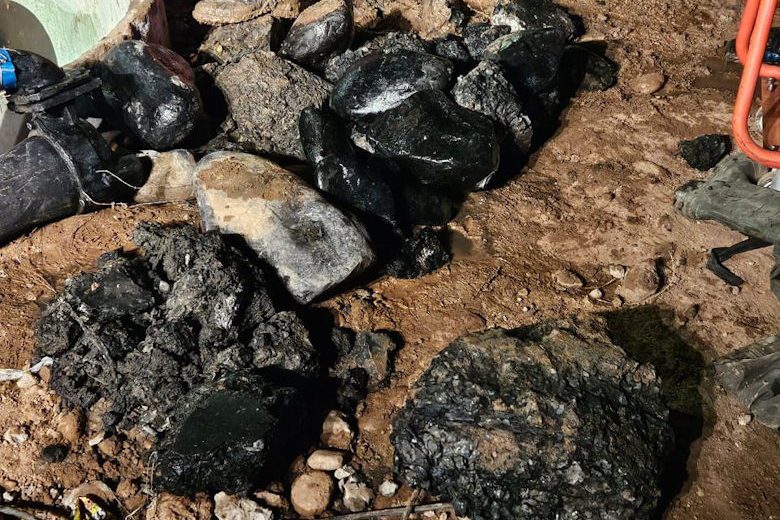The Oudtshoorn Municipality has activated an urgent environmental action plan following a significant sewage spill that impacted the Grobbelaars River on 18 July 2025. The incident, caused by deliberate vandalism to critical sewer infrastructure, resulted in the overflow of untreated sewage into the river system, posing serious environmental and public health risks.
The initial blockage occurred near the new Klein Karoo Markt development, affecting the East Bank bulk outfall sewer line along Langenhoven Road. Due to the extreme depth of the sewer line (over five metres), large pipe diameter (630 mm), and high flow conditions, standard municipal equipment could not resolve the blockage. Specialist contractors were brought in, and emergency teams worked around the clock to stabilise the situation.
According to Chris Swart, Senior Manager Water and Sewerage at Technical Services, “a temporary bypass system was installed to divert the flow, and multiple pumps were eventually required to manage flow volumes and access the blocked manhole. Full restoration of sewer function was achieved by the early hours of 30 July 2025.”
Swart further mentioned that “unfortunately, peak flow periods during the emergency response did result in limited overflows into the Grobbelaars River, which were immediately reported to the Department of Environmental Affairs and Development Planning (DEADP), the Municipal Environmental Officer: Ambrose Carelse and the public via different municipal platforms.”
Carelse stated, “While the emergency was swiftly brought under control, it is critical that we now focus on long-term rehabilitation of the affected areas and continuous water quality monitoring to ensure the safety of our residents, farmers, and the river ecosystem.”
The municipality can confirm that the original blockage was caused by an act of vandalism involving the attempted theft of steel reinforcement from a manhole cover. The vandalised manhole has since been sealed with a solid concrete slab to prevent recurrence.
In recent Facebook posts, the municipality informed residents of the incident and assured the public that clean-up and monitoring efforts were underway. The municipality has committed to transparent communication and will continue to update the public as test results become available.
The clean-up and recovery operation will unfold in three key phases
Phase 1: Waste Removal and Vegetation Clearing
Manual removal of solid waste and contaminated vegetation is underway along the affected riverbanks, with teams from Environmental Services, Cleansing, and Fire & Disaster Management on site.
Phase 2: Water Quality Monitoring
A minimum three-week testing programme has commenced at multiple points along the river to monitor water quality, including E. coli and ammonia levels. This will determine when it is safe for downstream users to resume water use for irrigation and livestock.
Phase 3: Potential Dam Flow Intervention
The municipality is assessing a controlled water release from a nearby dam to assist with flushing and dilution, should test results warrant such an intervention.
Mkhululi Yekani, Municipal Manager, said, “Ongoing efforts also include interdepartmental coordination to secure the affected areas, prevent unauthorised dumping, and, if necessary, arrange for an alternative water supply to impacted farmers.”
Yekani also want to urge residents to avoid contact with the Grobbelaars River until further notice and to refrain from using river water for irrigation or livestock until test results confirm safety.
To support the clean-up and recovery process, the municipality has formally engaged the Western Cape Department of Environmental Affairs and Development Planning, the Department of Water and Sanitation, and other relevant agencies for technical support and resources.
The Grobbelaars River is an important water source in the Oudtshoorn region and is used by several farmers and rural communities. In the wake of the spill, a downstream farmer reported the illness and death of livestock believed to have consumed contaminated river water. Biological and water samples have been collected, and investigations are ongoing.
The municipality has also launched a capital project to install vandal-proof manhole covers in identified high-risk areas during the 2025/26 financial year. Preliminary estimates indicate that the total cost of this emergency response is approximately R1 million. This includes specialist contractor fees, pump and equipment hire, temporary power supply, and security arrangements.
Yekani emphasised, “The health of our people and the integrity of our environment is not negotiable. We are committed to a full rehabilitation of the Grobbelaars River.”
Swart extends his sincere thanks to all municipal staff, contractors, environmental officers, stakeholders and community members who assisted in this complex operation.
The municipality urges the public to please report any suspicious activity near municipal infrastructure.



